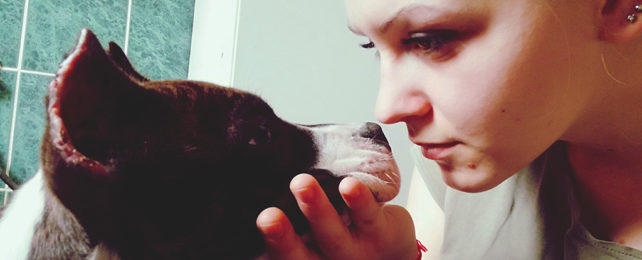Being under stress can cause all kinds of physiological shifts in the human body, from heart rates to the chemicals released into the bloodstream – and it turns out our canine pals can sniff out those stress-related changes, even in strangers.
Of course, we already know that dogs are super-sniffers, but this new study is the first time that researchers have explored in tightly controlled lab experiments how a doggo's knack for recognizing odors could help them identify when humans are in a stressful situation.
Besides giving us a deeper understanding of the relationship between pooches and their owners, the research can be used to improve training for dogs that are involved in support for anxiety, panic attacks, and post-traumatic stress disorder (PTSD).
"The findings show that we, as humans, produce different smells through our sweat and breath when we are stressed, and dogs can tell this apart from our smell when relaxed – even if it is someone they do not know," says animal behavior researcher Clara Wilson from Queen's University Belfast in the UK.
"The research highlights that dogs do not need visual or audio cues to pick up on human stress."
The study involved four dogs – Treo, Fingal, Soot, and Winnie – and 36 people, with a total of 720 smell tests carried out in total. The human volunteers were asked to complete a difficult math problem and self-report their stress levels at the same time.
Once each human participant's blood pressure and heart rate had increased, sweat and breath samples were taken. These were then presented to the dogs to see if the canines could alert researchers to the stress samples among baseline control samples: relaxed samples taken four minutes before the task began.
Sure enough, that's exactly what the dogs did, with a high level of accuracy. In 94 percent of the 720 trials, the dogs were able to correctly alert researchers to the stress sample.
"It was pretty amazing to see them be so confident in telling me 'nope, these two things definitely smell different'," Wilson told The Guardian.
It seems that chemical changes induced by stress can be picked up on by dogs, with smells the only information to go off.
It wasn't just the researchers who were impressed by the results of the trials – the owner of a two-year-old Cocker Spaniel named Treo reported that their pooch was very excited to see the researchers and take part in the study, even independently navigating his way to the lab.
"The study made us more aware of a dog's ability to use their nose to 'see' the world," says Helen Parks, Treo's owner. "We believe this study really developed Treo's ability to sense a change in emotion at home.
"The study reinforced for us that dogs are highly sensitive and intuitive animals and there is immense value in using what they do best – sniffing!"
Earlier studies have shown that dogs can mirror our levels of stress and detect emotions like happiness and fear through the smells that we give off – and this new piece of research ties those two findings together nicely with some detailed data collection.
The new study could give some useful insights into how dogs see (well, smell) the world, and interact with the people they encounter along the way.
We know that when it comes to pooches matching the mood of the people they're with, smell seems to play a strong role. It may also be that dogs are sensitive to their owner's emotions and seek to comfort or relieve their distress.
We can add this to the long list of subtle shifts in humans that dogs are able to smell, even when visible signs aren't present. You might remember that canines have previously been used to sniff out COVID-19 infections, for example.
"This is the first study of its kind, and it provides evidence that dogs can smell stress from breath and sweat alone, which could be useful when training service dogs and therapy dogs," says Wilson.
"It also helps to shed more light on the human-dog relationship and adds to our understanding of how dogs may interpret and interact with human psychological states."
The research has been published in PLOS ONE.
